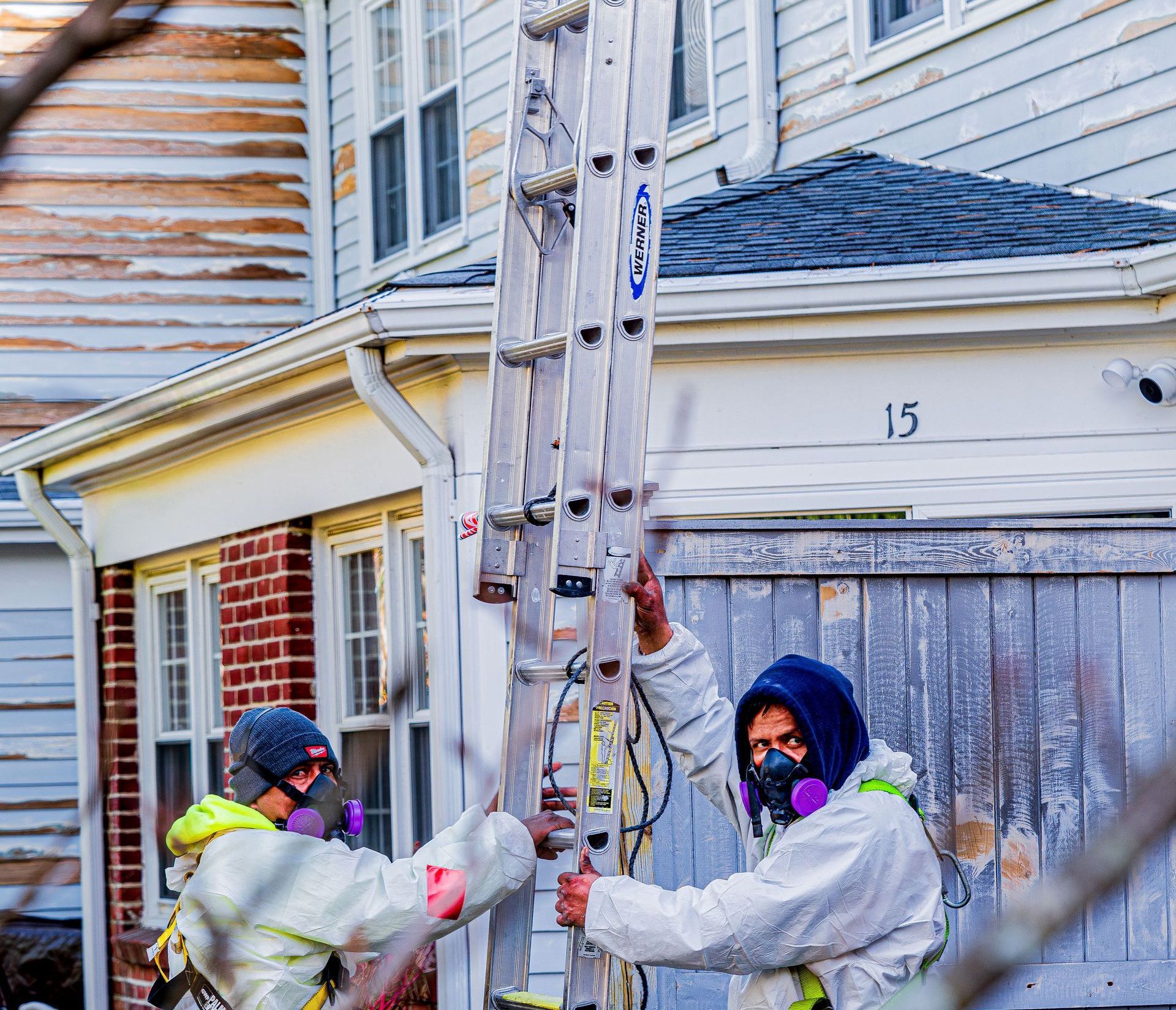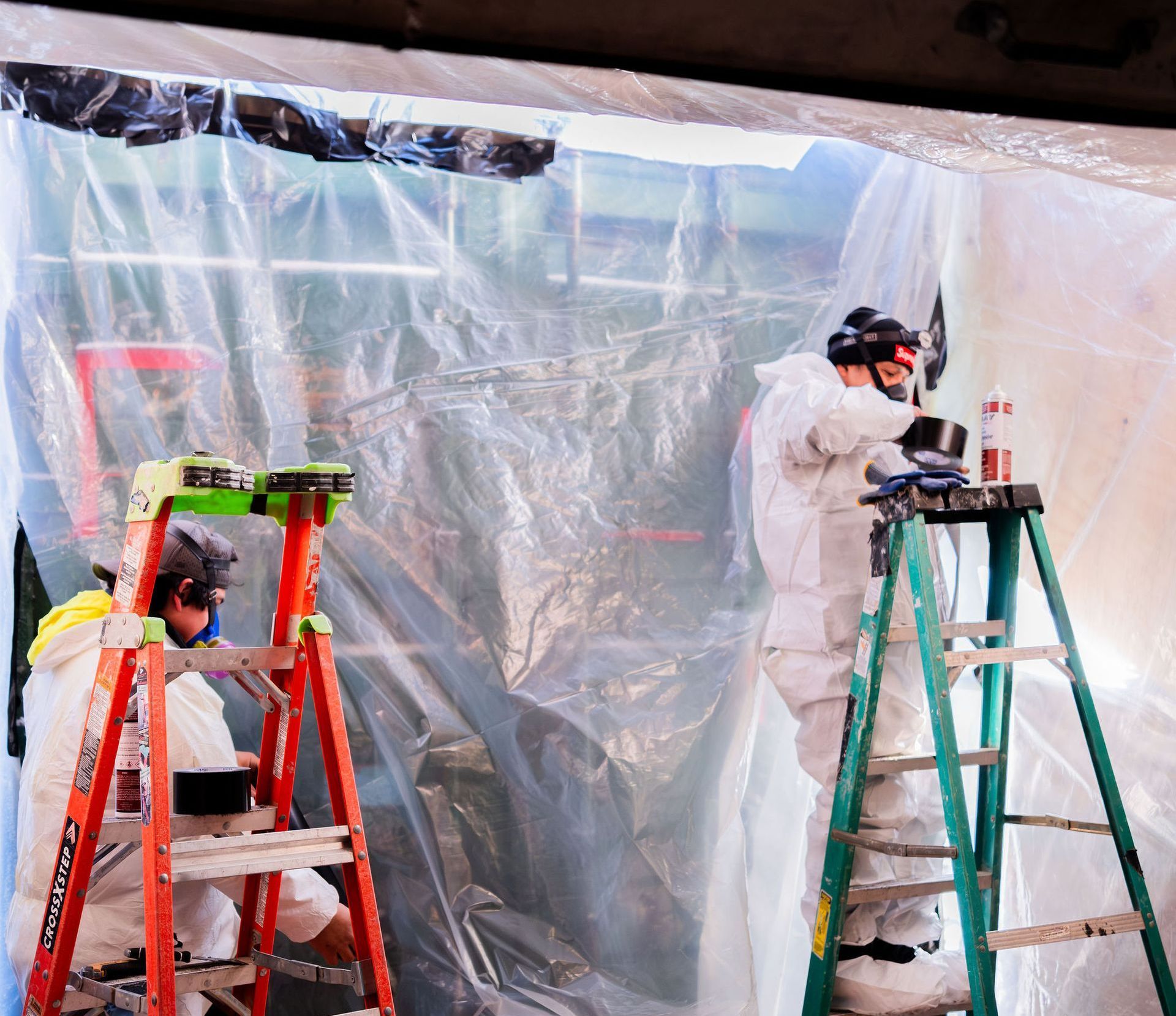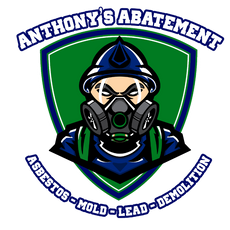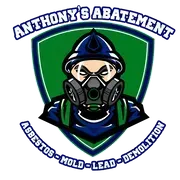Trust A Company With 10 Years Experience In Lead Paint Removal
LEADERS IN LEAD PAINT REMOVAL IN CONNECTICUT

Lead-based paint is a type of paint that contains lead as a pigment. It was commonly used in homes and buildings before its health risks were widely recognized. At the time, the use of lead in paint provided durability, color stability, and moisture resistance. Lead-based paint was particularly popular in the early to mid-20th century, before it was banned in 1978.
Since then, the existence of lead-based paint has been a significant health concern as studies showed that lead exposure, especially to children, could have severe developmental and neurological effects.
When lead-based paint deteriorates, it can create lead dust and chips, which, if ingested or inhaled, can lead to lead poisoning. Children are particularly vulnerable to lead poisoning as their developing bodies absorb lead more easily. At Anthonys Abatement, we’ve been dedicated to removing lead-based paint and other contaminants from Connecticut homes for the past 10 years. It is crucial to conduct child tests for lead, especially for children between 9 months and 35 months, to prevent severe health issues.
What is Lead Paint and Its Hazards
Lead paint, once a popular choice for its durability and vibrant colors, contains lead as a pigment. This type of paint was widely used in homes and buildings before its health risks were fully understood. Although it was banned in 1978, many older homes still contain lead-based paint. When this paint deteriorates, it can produce lead dust and chips, which pose significant health risks if ingested or inhaled.
Children are particularly vulnerable to lead poisoning because their developing bodies absorb lead more easily. Lead exposure can lead to severe developmental and neurological issues, including cognitive impairments, behavioral problems, and organ damage. It can also increase the risk of anemia, kidney damage, and reproductive problems. Understanding these hazards underscores the importance of addressing lead paint in older homes to protect your family’s health.
The 1978 Banning of Lead Paint Use
In response to growing awareness about the hazards of lead-based paint, regulations were implemented to ban or restrict its use. In the United States, for example, the federal government banned the use of lead-based paint in residential properties built after 1978.
Houses built before these regulations may still have lead-based paint present on walls, windows, doors, and other surfaces. As such, homes constructed before the 1980s are more likely to contain lead-based paint. Local health departments may issue a lead abatement order requiring homeowners to address lead hazards. Proper management, repair, and, if necessary, removal of lead-based paint are essential to prevent exposure and safeguard the health of occupants, particularly children.
History of Lead Paint Use in CT
Connecticut has a rich history, and with it comes the legacy of lead paint use in many of its homes and buildings. Before the federal government banned lead-based paint in residential properties in 1978, it was a common choice for its durability and aesthetic appeal. As a result, many homes built before this ban still contain lead-based paint on walls, windows, doors, and other surfaces.
The Connecticut Department of Public Health has been proactive in addressing the issue of lead paint. They have launched several initiatives to promote lead paint removal and abatement, aiming to reduce the health risks associated with lead exposure. These efforts are crucial in safeguarding public health, especially for Connecticut children who are most at risk of lead poisoning.
How Can I Tell If My Connecticut Home Has Lead Paint?
Determining if your home has lead paint requires careful observation and, in some cases, testing. Here are steps to help you identify lead paint:
- Age of the Home: In Connecticut, if your home was built before 1978, there's a higher likelihood of lead-based paint being used. The U.S. government banned the use of lead-based paint in residential properties in 1978.
- Visual Inspection: Inspect painted surfaces for characteristics common to lead paint. It often has a distinct, chalky appearance and can be easily scratched with a coin.
- Peeling, Chipping, or Chalking Paint: Lead-based paint deteriorates over time, leading to peeling, chipping, or chalking paint. This can create lead dust and chips, which are hazardous if ingested or inhaled.
- Paint Layers: Check for multiple layers of paint. If older layers contain lead-based paint, subsequent layers could be contaminated even if they don't contain lead.
- Window Sills and Frames: Lead paint was frequently used on windows, so inspect window sills and frames for chipping or deteriorating paint.
- Doors and Trim: Similarly, doors, trim, and baseboards could have lead-based paint, especially in older homes.
- Testing: The most definitive way to determine if you have lead-based paint is through testing. For accurate results, consider hiring a certified lead inspector. Anthonys Abatement provides comprehensive lead paint testing services in all of Connecticut. We typically can get to your home within 48 hours of you contacting us.
- Professional Inspection: If you're uncertain or worried about lead paint, consult a certified lead inspector or risk assessor. They have the expertise to identify and assess potential hazards.
Remember, the presence of lead-based paint doesn't necessarily mean you must remove it immediately. If the paint is in good condition and not deteriorating, it might be safer to leave it undisturbed. However, if you're planning renovations or if the paint is deteriorating, it's best to consult professionals for safe removal or encapsulation. Always prioritize the safety of your family and follow recommended guidelines when dealing with lead-based paint.
What Are the Health Risks of Lead Exposure?
Exposure to lead can have serious health risks, particularly for children, pregnant women, and adults with prolonged or repeated exposure. Lead is a toxic substance that can affect multiple organs and systems in the body. Here are the health risks associated with lead exposure:
Children's Developmental Effects:
Lead exposure in children can lead to developmental and cognitive issues, including lowered IQ, learning disabilities, attention deficits, and behavioral problems. Young children are especially vulnerable as their growing bodies absorb lead more easily.
Neurological Damage:
Lead can impair the nervous system, causing headaches, irritability, mood changes, and even seizures in severe cases.
Gastrointestinal Effects:
Ingesting lead-contaminated substances can cause stomachaches, vomiting, constipation, and loss of appetite.
Hematological Effects:
Lead exposure can lead to anemia, a condition where the body lacks enough healthy red blood cells to carry oxygen to tissues.
Cardiovascular Effects:
Even low levels of lead exposure are linked to increased blood pressure and an increased risk of heart disease.
Kidney Damage:
Lead can accumulate in the kidneys and cause damage over time, potentially leading to kidney disease.
Reproductive and Pregnancy Risks:
Lead exposure during pregnancy can harm fetal development, leading to premature birth, low birth weight, and developmental delays.
Immune System Impairment:
Lead exposure can weaken the immune system, making the body more susceptible to infections.
Bone Health:
Lead is stored in bones, and chronic exposure can affect bone health and lead to bone pain and fractures.
Long-Term Health Effects:
Prolonged or repeated exposure to lead over time can contribute to serious health problems in adulthood, including cognitive decline and increased risk of neurodegenerative diseases.
It's important to note that even low levels of lead exposure can be harmful, and there is no safe threshold for lead in the body. Prevention and minimizing exposure are crucial. If you suspect lead exposure, especially in children, consult a healthcare professional for testing and guidance. Additionally, taking precautions to identify and address sources of lead, such as lead-based paint in older homes, is essential for maintaining a safe living environment.
Can I Remove Lead Paint Myself?
While technically it is possible to remove lead paint yourself, it's an extremely dangerous task and is not a suitable project for most do-it-yourself property owners. Lead paint removal is a specialized task that requires knowledge, proper equipment, and adherence to safety protocols to prevent lead exposure. Inexperienced removal practices can send tiny paint particles floating in the air can create a extremely dangerous environment. Here are some important points to consider if you're thinking about removing lead paint yourself:
Lead Removal Isn't Common Knowledge
Proper lead paint removal requires specialized knowledge of lead hazards, safe removal practices, and containment methods. Without proper training, you may inadvertently create a more hazardous environment during removal.

Safe Lead Removal Requires Specialized Equipment
Lead paint removal requires specialized equipment such as HEPA vacuums, respirators, and protective clothing to minimize exposure. Without these tools, your safety is compromised.
Lead Dust Spreads
DIY removal methods often lead to the dispersion of lead dust throughout the home. This dust can settle on surfaces and remain a health hazard for an extended period.
Legal and Regulatory Compliance
Laws and regulations govern lead paint removal due to its hazardous nature. DIY removal may not comply with these regulations, leading to potential legal consequences.
Lead Paint Removal is Complex Work
Proper lead paint removal involves a series of meticulous steps, including containment, wet methods, proper waste disposal, and cleaning protocols. Professionals are trained to carry out these steps effectively.
Long Term Costs
Ineffective DIY removal can lead to incomplete removal and residual lead hazards, ultimately requiring professional intervention to rectify the situation.
Given the health risks and complexities involved in lead paint removal, it's advisable to consult certified lead abatement professionals for safe and effective removal. Their expertise ensures that lead hazards are properly addressed without endangering the health of your family or the environment. Your safety and the well-being of your loved ones should always be the top priority when dealing with lead paint. Trust the experts at Anthony's Abatement to properly remove the lead paint from your property. Get a certificate of completion at the end of our work and live with peace of mind that your home is safe and lead-free.
Schedule a Free Home Safety Evaluation
For more information about our lead services or to schedule an appointment, call us at (959) 202-2675 or complete the form below and we’ll get back to you as soon as we can.
Other Services
Request a Free Estimate
To schedule your free estimate, give us a call at (959) 202-2675or click below to our contact page and complete the form.
Read Our Verified Reviews!
There are Plenty of Mold & Asbestos Removal Companies in Connecticut
So Why Choose Anthonys Abatement?
Exceptional Customer Service
Speak with a real person, our responsive office staff will get you an estimate within 24 hours.
Experienced, On-time Crews
All technicians have 10-15 years of experience. We use cutting edge technologies and tools to ensure you get accurate results, quickly.
Licensed & Regulation Compliant
We're fully licensed and strictly adhere to all environmental regulations and industry standards.
Local, Family Owned
Anthony's Abatement is family-owned and operated and has been serving CT for over 10 years.
Based in West Hartford, CT
Serving the Whole State of Connecticut
Anthony's Abatement proudly services the entire state of Connecticut. We are committed to delivering exceptional abatement solutions to our valued clients in all areas, ensuring that no corner of the state is left unattended.




